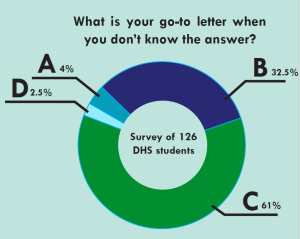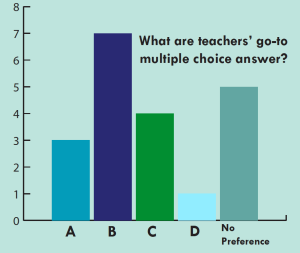The three main components of finals at Dexter High School
By Caden Koenig, Truman Stovall, Gigi Saadeldin & Nick LeBlanc
Test-Taking
Test-taking is hard enough, especially with all of the pressure of final exams; nevertheless, being confident in an answer should be all it takes for you to fill in the bubble “A”, “B”, “C”, “D”, or even that unsavory “E.” Sadly, this is not the reality students are met with during tests due to individual thought processes, especially on finals week.
Too many consecutive answers have been a problem with multiple choice tests since their creation. Every time you fill in the same letter, your brain begins to think that the chances of the next one being that letter diminish exponentially.
This concept affects some students more than others.
“It only takes three consecutive bubbles of the same letter for me to second-guess my answers,” Junior Tyler Woelfel said. “After four, I’m going to change one of my answers to break the streak, no matter what. Teachers should not be allowed to [create tests with multiple consecutive answers] because it is mean and it tricks you.”

Another junior, Vedhika Raghunathan, is relatively unaffected.
“It takes around six or seven in a row for me to go back and check my answers,” Raghunathan said. “Obviously, I think teachers should mix up the answers for questions, but it’s not that big of a deal.”
Luckily for students more like Woelfel, students aren’t the only ones who are starting to recognize this inconvenience. Some teachers are starting to notice the impacts of inadvertently creating answer keys with multiple answers corresponding to one letter.
“To be honest, when I create a multiple choice test I do not pay a lot of attention to where the answer falls in the letter choices,” Psychology teacher Tracy Stahl said. “However, with that being said, I have found that I have a lot of C’s and D’s on my answer keys. Since this realization, I am trying to be a bit more cognizant of where my [multiple choice] answers fall.”

Nobody can deny that most students would prefer school without finals; however, as long as standardized tests are implemented, these problems will most likely linger.
Stress
Stress is a state of mental or emotional strain resulting from extremely demanding circumstances.
According to psychiatrist Robert Leahy, the average high school student experiences more stress and anxiety than the average psychiatric patient from the 1950s.
While high school students experience stress daily from being expected to take rigorous classes, participate in time consuming extracurricular activities, and complete hours upon hours of homework — there is a dreaded time at the end of each semester which brings students to an even higher level of stress: finals week.
“I’ve seen kids start crying,” English teacher Jill Fyke said. “Kids have physically started crying because they were so worried about their exams.”
At Dexter High School students can take up to six final exams, counting as 20 percent of their overall grade in each class, over a three-day period.
“It’s really stressful,” senior Alexis Benson said. “We have so many exams in such a short period of time. It’s hard to focus on each subject when there are so many.”
Common responses to stress include tiredness, worry, irregular sleeping and eating habits, inability to concentrate, and shortness of memory.
“If I don’t do well on my finals, it would severely impact my grade point average, my friends, my family, and my overall self-esteem,” Benson said.
“If I do poorly on the exam it could lower my grade,” junior Will Liskiewicz said. “Which could lower my grade point and affect whether or not I get into certain colleges.”
“In the scheme of things, it’s pointless to stress out,” Fyke said. “There’s so much wasted energy worrying. If you care about your grade early on, what you get on your final exam won’t matter. You’ll be doing well enough in the class.”
To a high schooler, getting an A or a C on a final exam can severely impact their acceptance into certain colleges.
“It’s a huge amount of points,” Benson said. “Knowing that you have this one sitting period to fail or pass is extremely stressful.”
According to a survey handed out by The Squall, a Dexter student gets on average six hours of sleep a night and has three to four hours of homework each night.
Out of 160 surveys, 157 students claimed that finals week adds more stress to their lives.
The average DHS student ranked themselves a seven on a 10-point stress-level scale.
“I have to pass all my classes to graduate, and I have to graduate in order to get a good job in life,” junior Liz Martinez said. “So, it builds up even more stress.”
Study Habits
For high school students, an incredible amount of importance is put on final exams. To ensure a good grade on the final, students have to have good study habits and techniques. Without good habits, students could see all of their hard work over the semester go to waste.
There are various ways students study, and these strategies can be obsolete if they don’t study often. It is fairly well known that high school students procrastinate, and this bad habit can lead to stressed, last-minute studying.
Despite this, some students incorporate beneficial techniques like study gum. Study gum is a technique where students chew a particular brand and flavor of gum during studying. Then during the final, the student chews the same gum to help remember what they studied. However, this isn’t the only way to study. Many Dexter High School students have different ways of tackling finals.
“I tend to study the review and read the book,” junior Tony Seidl said. “I also make sure more time is spent focusing on the harder classes.”
Knowing the importance of finals, teachers try and help students prepare and study for finals. A common suggestion from teachers is to study for 20-30 minutes then take a 10 minute break. When students have multiple courses to study for, small, spaced out study sessions can be beneficial. Nevertheless, teachers don’t all have the same advice.
“I don’t tell my students to study for a specific time,” science teacher Suzanne Spence said. “The amount of time to study is different for every person, and each student should interval their study time until they feel comfortable with the topic.”
Depending on the grade in the class, students will form different techniques for studying. Having experienced more finals, juniors and seniors acknowledge the need to study.
“I used to never study, but since I now know the importance of finals, I devote time to study,” Seidl said.
Comparatively, underclassmen, admitted to devote less time to study.
“I hardly study for my normal classes,” sophomore Matthew Bellas said. “The only time I spend studying for my finals is for advanced classes.”
No matter the technique, students understand that to improve or maintain their grade, they will have to put some sort of effort into studying. But studying for finals isn’t purely beneficial. It can also have a negative side effect.

